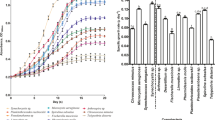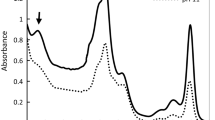Abstract
Ten strains of filamentous, heterocystous nitrogen-fixing blue-green algae (cyanobacteria) were screened for growth performance and tolerance to temperature, pH, irradiance and salinity, together with their potential as producers of phycobiliprotein pigments. Phycobiliproteins typically accounted for about 50% total cell protein, the prevalent type being C-phycocyanin, followed by alloppycocyanin, with levels of 17 and 11% d.wt, respectively, in some strains of Anabaena and Nostoc. C-phycoerythrin was the major pigment in several Nostoc strains, reaching 10% d.wt. Some strains represent, therefore, excellent sources of one or more phycobiliproteins. All strains tolerated an irradiance of ca 2000 µmol photon m-2 s-1. Anabaena sp. ATCC 33047 and Nostoc sp. (Albufera) exhibited the widest optimum range of both temperature (30–45 and 25–40 °C) and pH (6.5–9.5 and 6.0–9.0) for growth, the former also showing significant salt tolerance. In an outdoor open system, productivity of cultures of two phycoerythrin-rich strains of Nostoc was over 20 g (d.wt) m-2 d-1 during summer. The growth performance of the allophycocyanin-rich Anabaena sp. ATCC 33047 in outdoor semi-continuous culture has been assessed throughout the year. Productivity values under optimized conditions ranged from 9 (winter) to 24 (summer) g (d.wt) m-2 d-1.
Similar content being viewed by others
References
Arnon DI, McSwain BD, Tsujimoto HY, Wada K (1974) Photochemical activity and components of membrane preparations from blue-green algae. I. Coexistence of two photosystems in relation to chlorophyll a and removal of phycocyanin. Biochim. Biophys. Acta 357: 231–245.
Borowitzka MA (1988) Vitamins and fine chemicals from microalgae. In Borowitzka MA, Borowitzka LJ (eds), Micro-algal Biotechnology, Cambridge University Press, Cambridge, 153–196.
Boussiba S (1993) Production of the nitrogen-fixing cyanobacterium Anabaena siamensis in a closed tubular reactor for rice farming. Microb. Releases 2: 35–39.
Bradford M (1976) A rapid and sensitive method for the quantitation of microgram quantities of protein utilizing the principle of protein-dye binding. Anal. Biochem. 72: 248–254.
Cohen Z (1986) Products from microalgae. In Richmond A (ed.), CRC Handbook of Microalgal Mass Culture, CRC Press, Boca Raton, Florida, 421–454.
Fontes AG, Vargas MA, Moreno J, Guerrero MG, Losada M (1987) Factors affecting the production of biomass by a nitrogen-fixing blue-green alga in outdoor culture. Biomass 13: 33–43.
Glazer AN (1994) Phycobiliproteins — a family of valuable, widely used fluorophores. J. appl. Phycol. 6: 105–112.
Gudin C (1988) Why bother with microalgae?. In Stadler T, Mollion J, Verdus MC, Karamanos Y, Morvan H, Christiaen D (eds), Algal Biotechnology, Elsevier Applied Science Publishers, London, 33–40.
Kochert G (1978) Protein determination by dye binding. In Hellebust JA, Craigie JS (eds), Handbook of Phycological Methods. Physiological and Biochemical Methods, Cambridge University Press, Cambridge, 91–93.
Mackinney J (1941) Absorption of light by chlorophyll solutions. J. biol. Chem. 140: 315–322.
Moreno J, Vargas MA, Fontes AG, Guerrero MG, Losada M (1987) Effect of several parameters on the productivity of a nitrogen-fixing blue-green alga in outdoor culture. In Terol S (ed.), Proceedings of the 1986 International Congress on Renewable Energy Sources, vol. I, Consejo Superior de Investigaciones Científicas, Madrid, 206–211.
Richmond A (1986) Cell response to environmental factors. In Richmond A (ed), CRC Handbook of Microalgal Mass Culture, CRC Press, Boca Raton, Florida, 69–99.
Richmond A (1988) Spirulina. In Borowitzka MA, Borowitzka LJ (eds), Micro-algal Biotechnology, Cambridge University Press, Cambridge, 85–121.
Richmond A (1992) Mass production of microalgae: a mode of industrial photosynthesis. In Barber J, Guerrero MG, Medrano H (eds), Trends in Photosynthesis Research, Intercept Limited, Andover, 305–317.
Rodríguez H, Rivas J, Guerrero MG, Losada M (1989) Nitrogen-fixing cyanobacterium with a high phycoerythrin content. Appl. envir. Microbiol. 55: 758–760.
Rodríguez H, Rivas J, Guerrero MG, Losada M (1991) Enhancement of phycobiliprotein production in nitrogen-fixing cyanobacteria. J. Biotechnol. 20: 263–270.
Rodríguez H, Vargas MA, Moreno J, Rivas J, Guerrero MG, Losada M (1992) Production of phycobiliproteins and exopolysaccharides by nitrogen-fixing blue-green algae. Effect of environmental and nutritional factors. In Kretschmer P, Pulz O, Gudin C (eds), Algology: 1st European Workshop on Microalgal Biotechnology. Proceedings, Institut für Getreideverarbeitung GmbH, Potsdam-Rehbrücke, 27–33.
Siegelman HW, Kycia JH (1978) Algal biliproteins. In Hellebust JA, Craigie JS (eds), Handbook of Phycological Methods. Physiological and Biochemical Methods, Cambridge University Press, Cambridge, 71–79.
Vonshak A (1988) Porphyridium. In Borowitzka MA, Borowitzka LJ (eds), Micro-algal Biotechnology, Cambridge University Press, Cambridge, 122–134.
Author information
Authors and Affiliations
Rights and permissions
About this article
Cite this article
Moreno, J., Rodríguez, H., Vargas, M.A. et al. Nitrogen-fixing cyanobacteria as source of phycobiliprotein pigments. Composition and growth performance of ten filamentous heterocystous strains. J Appl Phycol 7, 17–23 (1995). https://doi.org/10.1007/BF00003545
Received:
Revised:
Accepted:
Issue Date:
DOI: https://doi.org/10.1007/BF00003545




